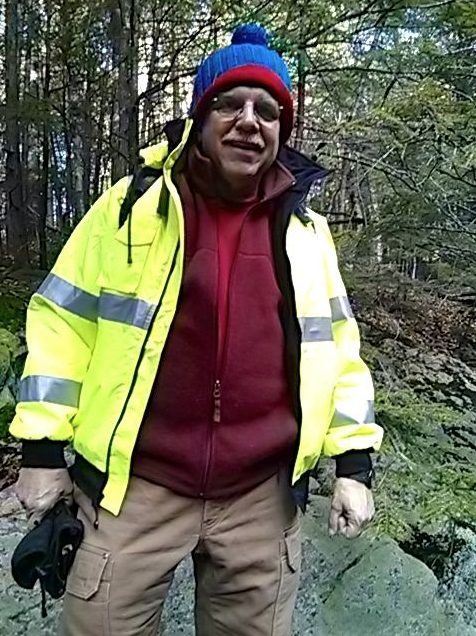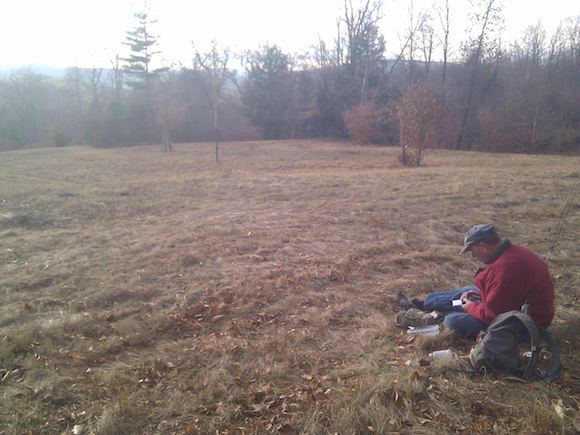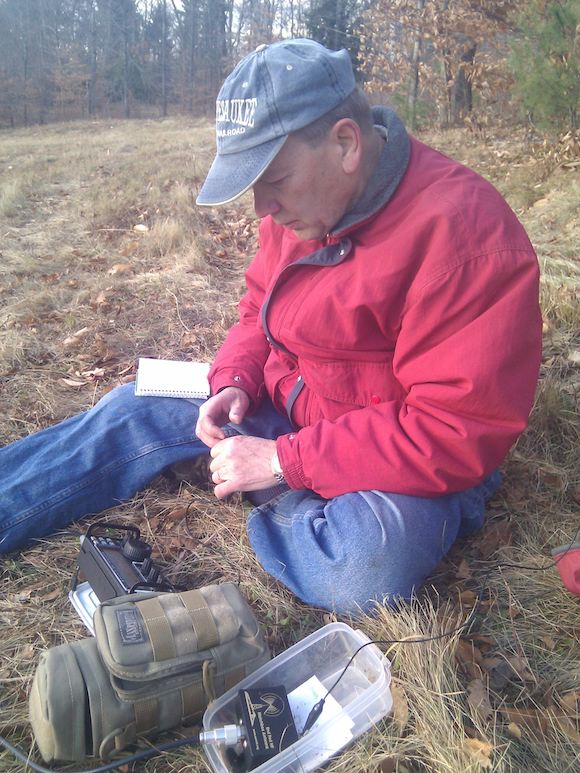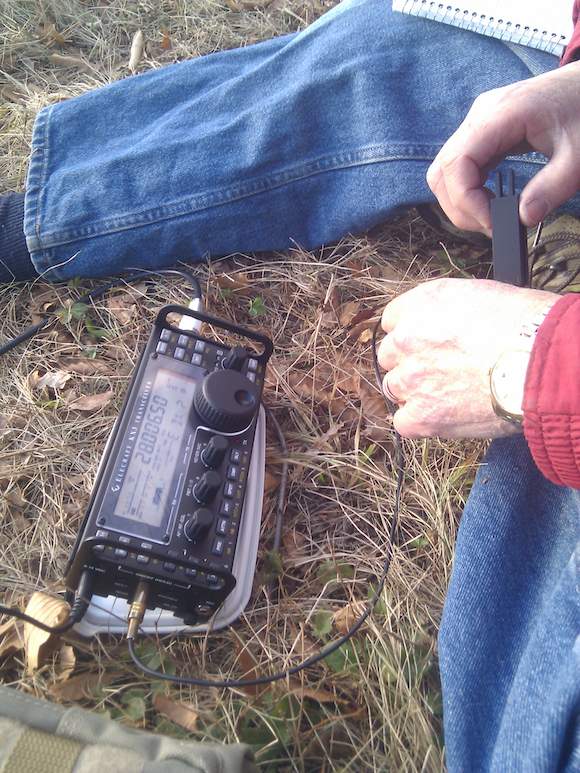“Tim, look at this. It’s tinder fungus. Do you know what that is?”
My Morse code mentor and good friend Jim Cluett, W1PID, was pointing to crescent-shaped growths on the outside of a 12-inch diameter birch tree.
He and I had just spent a few minutes admiring the tall waterfalls on my 90 acres of woods in central New Hampshire. We were taking a hike and planning to operate his fancy Elecraft KX3 portable transceiver. This rig is magic in a box.
“I have no clue. I’ve never heard of that stuff,” I replied while adjusting my bright red and blue knit hat. I was a walking beacon in the woods wearing my lime-green Milwaukee heated jacket and soft knitted hat. It was hunting season in New Hampshire and I didn’t want to be mistaken for a burly brown buck.
While my heated jacket was equipped with a 12-volt lithium-ion battery, I soon discovered walking was all I needed to keep warm. Minutes into the hike I had opened my jacket to stay comfortable.

The jacket is much brighter than it appears here. Hiking in the brisk weather was invigorating. Photo credit: Jim Cluett, W1PID
“Well, it’s great stuff to use in a fire piston. Do you know what that is?”
“Fire piston? What in the world is that?”
Spending an afternoon with Jim I was discovering was not much different than what Bilbo Baggins must have experienced as he and Gandalf walked together towards the Misty Mountains.
Jim even looked the part of Gandalf with his beaver-chiseled walking stick given to him by his daughter. She had plucked it from a beaver dam a few years before and thought it would be a grand gift for her dad. Based on the silky smooth surface of the upper part of the shaft I was certain it was a cherished heirloom. The branch was polished by Jim’s hand having walked countless miles with it.
“A fire piston is a clever device you use in the wild to make a fire. It works like a diesel engine using compression to create high temperatures that ignite a small piece of the fungus. You then take that little ember and use it to start a fire,” expounded Jim.

This is where we eventually set up to operate. It looks misty in the photo, but it wasn’t. Photo credit: Tim Carter, W3ATB
What else was I going to discover this late fall day? It was mostly sunny, but brisk. A weather system was bearing down on us from central Canada promising to usher in the first measurable snow of the season and quite cold temperatures. The forecast low for the upcoming night was 18 F. Mother Nature didn’t disappoint as I discovered the next day.
Jim and I were trying to take advantage of one of the final great hiking days of the season. I was the leader and Jim said it was my adventure. He was following me wherever I wanted to go. My thought was to take him to see two of the three major cascades along Blake Brook and then head up to higher ground to operate CW on his tiny multi-band radio.
I had been waiting for this day for months. Jim routinely hikes outdoors taking his small radio with him. Just as the radio is multi-band stretching from 160-6 meters, Jim operates CW in the field for both enjoyment and to hone his skills if there’s an emergency. Each time he slings his water bottle 40 feet in the air to snag a branch for his thin wire antenna, he’s multi-tasking. He wants to be able to operate in the field no matter what the weather conditions might be. It’s what you’d expect from a pro.
Just a week before he told me on the phone, “Tim, the KX3 only draws 150 mA in the receive mode. When transmitting on low power, it uses very little energy. You can operate for hours in the field if need be with this rig. Your ICOM-7000 draws 2 amps in receive. You’ll be packing a big battery with you if you want to operate.”
After viewing a second waterfalls and round pothole drilled into the bedrock by swirling waters and gravel at the base of the falls, it was time to head back towards the warm sunny field where we’d set up his rig to see who was on the air.
“You know one of the things I love about operating in the field?” Jim exclaimed as we we hiked up away from the falls and through the forest.
“I often wonder if I’m the first person to ever operate a portable radio from that exact place in the world.”

Here’s Jim operating a tiny iambic paddle to send the characteristic di’s and dah’s that are part of a CW signal. Photo credit: Tim Carter, W3ATB
“Well, I have to believe that’s the case today. I can tell you I’ve never had the chance to operate a HF radio on this property. My guess is no one else ever has either.”
About thirty minutes later Jim and I saw the freshly cut brown grass laying flat in the large field as we cut sideways across the sloping leaf covered forest floor. Our footfalls crushed the dry leaves making a wonderful crunching noise.
The open south-facing field would make a perfect place to capture some of the invisible radio waves that were bouncing all around us. We weren’t going to be denied. Fortunately it was mostly sunny with puffy white clouds racing across the sky in advance of the cold front.
Jim took off his compact backpack. Inside was everything he needed to communicate with people all over the globe. The radio and battery fit inside a small tubular canvas carrying case and all the other things he required were inside a translucent plastic case you’d store leftover food.
It only took a few minutes of setup to be on the air. Within 15 minutes Jim had gathered four contacts on 10, 15 and 20 meters. There was a world-wide CQ contest running clogging many of the bands, so QSOs were fast sharing just the most basic information.
For the past nine months I’ve been in awe of Jim’s CW skills. He’s been doing CW for over 50 years so you’d expect him to be have great skills and magic when using this method of communication.
As he operated, I would lean in to look at the amazing Elecraft portable radio. I’d seen photos of it in many of the stories he’d written about his outdoor radio adventures, but had never seen it in operation.

Here it is, the superb Elecraft KX3. Look closely at the lower right corner of the LCD screen. Photo credit: Tim Carter, W3ATB
“These handles on the side I bought from another guy. When you put on the clear plastic cover, they work well to protect the radio knobs from damage as you transport the rig.” Jim was right.
As the sun sank in the sky, it went behind a giant evergreen tree placing us in a shadow. It didn’t take long at all before we started to get cold. Jim was trying to make his last contact and I was looking at the large LCD screen that showed all sorts of data.
I could see the SWR meter moving about but something else caught my eye in the lower right corner. Why were those letters moving across the screen? Wait a minute, didn’t I see PID there and something else scrolling from right to left much like you see the newsfeed crawl when watching cable TV news or the weather?
“Hey, this radio is translating the Morse code for you!” My eyes were bigger than silver dollars.
An impish grin formed on Jim’s face and I believe he uttered, “Oh, I don’t look at that. I guess I should have turned that off. You don’t think I need that after 50 years of doing CW do you?”
No, Jim I don’t. But we’ll never know, will we?
Too bad you can’t see the grin on my face as I type this.
Did this blog post help you?
I invest time writing and taping videos to help other hams like you save time and lower their blood pressure. Frequently equipment manuals are lacking key details that cause frustration. I’m trying to fill in those gaps when I can.
If this post saved you some frustration, I’d appreciate it if you’d consider making a simple donation – even just a buck – using the PayPal button below. The more donations I receive, the more time I can devote to helping you.
Thanks in advance.

Tim, Thank you so much for sharing all your ham radio adventures. Back in 1990 when I was 21, I got my novice license, but due to a chronic illness and concentration problems, was never able to go farther. I know things in the amateur radio world have changed a bit since then, and I still have a dream of being able to get my license again and do this. I will need a really good tutorial series. Do you have any recommendations on the best system for learning? Also, what brand of radio would you buy at the appropriate time. I’d like something hand-held, and would love to have something that could translate morse code if possible, even though I still want to learn it.
Thanks,
Roy
I have mad a fire piston. Went to Lowes and bought an Al pipe and an Al rod that fit with fairly tight tolerances into the pipe. Then used a stick welder with some Al welding rod to close one end of the pipe. Cut the rod to fit with a notch for an o ring and a cut on the end to hold a small piece of cotton. Used cotton that had been preheated in a metal box with a small hole so it carbonized but did not catch fire. Slammed the rod into the pipe and I got embers. Fun!
Really neat. I don’t do CW but can appreciate those that do.
You are so lucky to have all that land. Oh the antenna farm you could make up on that land. Maybe you already have such a system set up.
73
Steve, kc4ybo
Steve,
I don’t have a house on that property. You’re so right about the antenna farm. I’ve dreamed about it. I have a high spot on the land that’s just slightly blocked by a nearby mountain towards the east. Oh could I get a signal out and in by putting a hex beam up there!